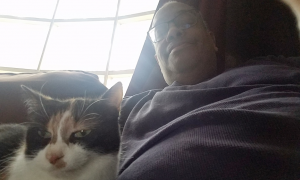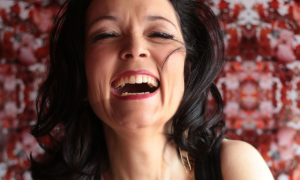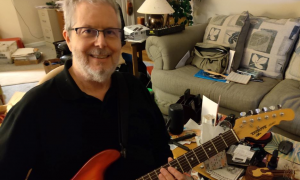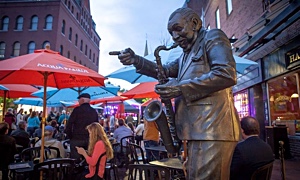Home » Jazz Articles » Meet the Staff » Meet Mary Foster Conklin
Meet Mary Foster Conklin

Courtesy Janis Wilkens
About Mary Foster Conklin
Mary Foster Conklin is a jazz vocalist based in New York City. She hosts A Broad Spectrum, a weekly broadcast celebrating women composers and lyricists on Sunday afternoons on the HD2 channel at WFDU FM based at Fairleigh Dickinson University in Teaneck, New Jersey. The campus closed down in March due to the pandemic, so the show is now prerecorded in her apartment (with the long distance assistance of engineer Jay Daniels, two tin cans and lots of string).What is your first-ever radio-related memory?
My father was a devoted fan of WQXR—every night he came home and would set himself up with a cocktail and Wise potato chips to listen to the news program and classical music at full blast. We were not allowed to speak while the radio was on.How did your fascination with radio start?
I had a small white transistor radio that I would listen to under the covers long into the night.What radio shows were a fan of, and why?
As a kid, I listened to WABC and WMCA (the good guys). AM radio was a real mix of old and new in the '60s: one could hear standards from Louis Armstrong and Peggy Lee alongside the more contemporary tunes of Donovan and the Beatles. I grew up attending the Riverside Church so I was aware of WRVR, although back then I was less into jazz. As a teenager, I shifted to FM and became a devoted fan of Allison Steele (the Night Bird) on WNEW. She had a late evening show that began with her huskily chanting poetry over flute music, which always set a magic vibe. I also loved the original Mixed Bag on Sundays hosted by Pete Fornatale and Vin Scelsa's late night insanity long before Idiot's Delight. His laugh was infectious.When did your jazz radio career start?
I first got into radio at Connecticut College, which was run by a passionate group of students who endlessly shared music discoveries with each other. My shows were a mix of rock, punk, fusion and jazz—whatever was my fancy in any given week. I returned to radio gradually as an adult—subbing at WBAI for David Kenney's standards show and assisting him with interviews, as I was now deep into song research as well as performing. When WFDU in New Jersey put out the call for programs on their HD2 channel, I went back on the air with my own show in 2016, playing women-driven jazz music plus many honorable men.Did you have a mentor or you are a self-made host?
I'm pretty much self-made, although I had help from other DJs along the way. These days I'm most grateful to my Canadian colleague George Evans who first taught me to work with a stopwatch.Do you recall the first album/song you ever presented on the radio?
In college, I had a morning show so I opened with "Percolations 1" from the Gong album Angel's Egg. I would close with either Phoebe Snow's "No Show Tonight" or "Kypros" from the Cat Stevens IzitsoWhat stations have you worked for?
WCNI in New London, CT, WBAI in New York City and WFDU in Teaneck, NJHow do you approach each show?
To me, the best programs highlight new releases, give birthday shoutouts, plug live shows and offer up history of the music we love. Women have always been a part of this legacy—I like to shine more light on the past and give those foremothers the attention they deserve. There is a real imbalance of women to men as far as airplay is concerned, especially with instrumentalists, but thankfully that is changing. It's become most important during these months of lockdown to remind listeners to buy (not just stream) artists' music and attend their online performances, as there are no live gigs.How long does it take you to produce a show?
Since I am working remotely, everything is digital. It takes a couple of hours to assemble a two hour program and then load the music files to the server. I then sit in my closet and record the vocal breaks which are then woven into the broadcast by my offsite engineer Jay Daniels of Simply Timeless Radio, who kindly reached out to me when the station closed to help keep me on the air.Are you a Vinyl, CDs, or Files host?
Of course I started out with vinyl and cassettes in college, then gradually transitioned to CDs and most recently digital files. I live in New York City in a tiny apartment with limited space, so digital files are most welcome because they are easiest to store.What is it that usually impresses you about a musician?
I love being surprised by music choices—both melodic and song selections. I'm a sucker for a smart lyric. Too many musicians don't work beyond the tired top 25 list of standards. Add to that the filter of music by women and it gets even more challenging. One more version of "On the Sunny Side of the Street" and I'll shoot myself. I'm also a fan of wordless scat and vocalese. My favorite singers not only get the message across, they are instrumentalists.How do you engage with your audience?
Of course the main focus is to share the music that excites me, which sometimes requires explanation and a little history. Since I live in New York City, it's also been important to report what's going on around me. I use social media quite a bit to communicate with my listeners. Facebook, Twitter and Instagram all serve to help me get the word out and keep in touch with people.Do you have a sense of who's listening to your shows?
Pretty much—it's a mix of musicians and jazz lovers, both male and female. Radio seems to have had a resurgence since the lockdown. It's been a thrill to turn people on to artists they are not familiar with, both old and new.How do you feel about "airwave radio" vs. "internet radio"?
I am a dinosaur, as Blossom Dearie used to say. I love hearing a DJ give me the weather and report on a live performance as well as play music. I've always been a fan of the local airwaves, but internet radio has allowed me to expand my listening base to the West Coast and also to Europe, which is very cool. I also get to tune in to other music shows worldwide, which is thrilling.If you were programming your final radio show, which songs would you open and close with?
Most likely I'd open with Adrienne Fenemor's "Mo' Puddin'" and close with the Vivien Garry Quintet "A Woman's Place Is In the Groove."Do you listen to other jazz radio shows? If so, which ones do you enjoy most?
I love local radio, so in NYC I listen to WBGO and WKCR, plus David Kenney's show on WBAI. Right now I'm in Gates County, North Carolina and driving a lot, so I listen to WHRV out of Norfolk, VA. As far as internet radio, I love tuning in to Linda Yohn's Swing Set on Sunday nights on WRCJ and catch Mondo Jazz on Mixcloud.Can you share a fun story that happened during your radio career?
A Broad Spectrum came into being several years ago, when a DJ friend got thrown out of his station on International Working Women's Day because no men were allowed. Without my knowledge, he volunteered me to do his show. I had three days to come up with a concept and two hours of music. Always fun to work under the gun.What is your favorite song to whistle or sing in the shower?
What day is it? I'm a vocalist so that changes constantly. I'm also a lousy whistler.If you could have dinner with anyone from jazz history, who would it be and why?
Mary Lou Williams—I wish like hell I'd been able to attend her classes in the '70s when my brother was at Duke. Also Dorothy Fields and Dorothy Parker because they were smart funny and suffered no fools. That would be some dinner party.What underrated album do you wish everyone knew about?
I need to give a massive shout out to feminist jazz historian Rosetta Reitz. I used to haunt Footlights Record shop in the East Village and discovered her Rosetta Records series featuring music of the early women of jazz and the blues which was a huge education. Unfortunately, most of the albums remain on vinyl, but are very much worth seeking out.How would you describe the state of jazz today?
It is a multi-headed beast, ever changing. I was first drawn to it when life events went beyond what words could describe and improvising in the moment was the only way through. I love the music language and also can't resist any groove that makes me move. It may always remain an acquired taste but it remains a very necessary art form.What are some of the essential requirements to keep jazz alive and growing?
Keep music education going in schools—can't say that enough. Children need to be exposed to jazz when they are young. I was blessed with great teachers and God knows music kept me out of more trouble when I was a teenager because I had passion and a focus.Listen to the Show
A Broad Spectrum< Previous
Markus Reuter, Ray Russell, Randy Bre...
Comments
Tags
Meet the Staff
Mary Foster Conklin
United States
New York
New York City
George Evans
Gong
Phoebe Snow
Cat Stevens
Blossom Dearie
Adrienne Fenemor
For the Love of Jazz
 All About Jazz has been a pillar of jazz since 1995, championing it as an art form and, more importantly, supporting the musicians who create it. Our enduring commitment has made "AAJ" one of the most culturally important websites of its kind, read by hundreds of thousands of fans, musicians and industry figures every month.
All About Jazz has been a pillar of jazz since 1995, championing it as an art form and, more importantly, supporting the musicians who create it. Our enduring commitment has made "AAJ" one of the most culturally important websites of its kind, read by hundreds of thousands of fans, musicians and industry figures every month.























